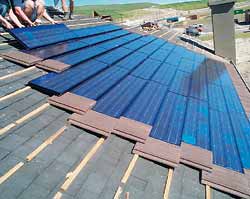How Is LEED Faring After Five Years in Use?
Assessing the assessment tool
Now that LEED has been available in one form or another for some five years, it's appropriate that the system has been reviewed externally and internally for various purposes. Among others, Chris Scheuer and Gregory Keoleian of the Center for Sustainable Systems at the University of Michigan evaluated LEED in a report for the National Institute of Standards and Technology titled "Evaluation of LEED Using Life-Cycle Assessment Methods," which was published in September 2002. Lisa Fay Matthiessen and Peter Morris of Davis Langdon analyzed the cost of green projects, including both those that did seek LEED certification and those that did not, and released their findings in a July 2004 document called "Costing Green: A Comprehensive Cost Database and Budgeting Methodology." This year, Auden Schendler, director of environmental affairs at Aspen Skiing Company, and Randy Udall of the Community Office for Resource Efficiency, both in Aspen, Colorado, coauthored a critique of LEED, called "LEED is Broken … Let's Fix It," that reads like a call to arms. And, although more politic in tone, Jay Stein and Rachel Reiss of Platts, a subscription Web division of The McGraw-Hill Companies, in their "Ensuring the Sustainability of Sustainability Design: What Designers Need to Know About LEED" point out inconsistencies and unknowns in the LEED system and suggest ways for designers to work around them.
|
Two big glitches
In its laudable desire to create a national rating protocol that could be easily understood and applied by all, USGBC developed a simple, universal system in which one goal, or credit, receives one point. From this seemingly reasonable structure, however, comes what appears to be two of the most fundamental criticisms of the current LEED framework: its bioregional insensitivity and its relatively tenuous connection to life-cycle analysis.
In truth, many sustainable design strategies are regional in character. They must take into account local climate, geography, resources, wildlife, and habitat. As Stein and Reiss note, "… water conservation is more of a priority in hot, dry climates, yet the USGBC awards the same number of credits for water conservation in Seattle as in Phoenix … ." One unintended consequence is that less environmentally conscientious design teams may choose the least expensive strategies recognized by LEED to get the respective credits, even though the implementation of those strategies may not substantially improve the project's sustainable contribution.
Life-cycle analysis, or LCA, refers to the scientific discipline of measuring the material resources and energy consumed, and the environmental impact created, by a particular product throughout its life. By comparing this data for alternative products, designers could-at least in theory-select the materials and components that cause the least environmental damage. But LEED's one-point-per-credit structure doesn't encourage this more sophisticated analysis. Stein and Reiss continue, "… when designing renovation projects, developers can save more material resources by reusing 75 percent of an existing building's structure and shell … than by incorporating at least 5 percent of salvaged or reused building materials, but both strategies earn one point in the LEED rating."










